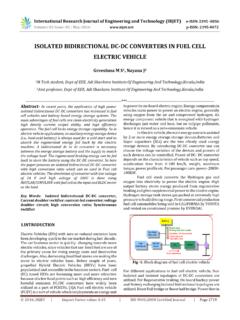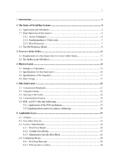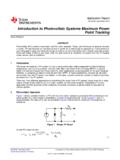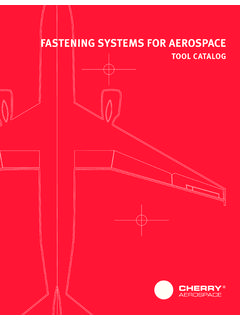Transcription of Voltage control for Photo Voltaic Systems with MPPT and ...
1 International Research Journal of Engineering and Technology (IRJET) e-ISSN: 2395 -0056 Volume: 02 Issue: 02 | May-2015 p-ISSN: 2395-0072 2015, All Rights Reserved Page 485 Voltage control for Photo Voltaic Systems with MPPT and Battery Storage in Micro grids , Kumar2 and 1 PG Scholar Department of EEE, Lakireddy Balireddy College of Engineering, Vijayawada, India 2, 3 Asst. Professor Department of EEE, Lakireddy Balireddy College of Engineering, Vijayawada, India ---------------------------------------- -----------------------------**--------- ---------------------------------------- --------------------ABSTRACT Distributed energy sources (DE) or Distributed generation with power electronics interface are capable of providing reactive power related to ancillary system services.
2 Power generation capability of Photo Voltaic (PV) Systems mainly depends on solar irradiance and temperature constraints while these are continuously varying, in order to extract maximum amount of power from PV system maximum power point tracking technique (MPPT) to be employed. In the point of power system reliability and Voltage stability local Voltage regulation has drawn much more importance. This paper proposes integrated control of Voltage at Voltage source inverter (VSI) ac side and MPPT algorithm at PV side along with Battery storage control . By these control techniques effective utilization of PV system can be achieved and also Voltage stability is improved. Also battery storage supports the PV system while in emergencies.
3 Key Words: Distributed energy resource (DER), distributed generation (DG), maximum power point tracking (MPPT), Voltage control , solar photovoltaic (PV). 1. INTRODUCTION Distributed generation, also called on-site generation, dispersed generation, embedded generation, decentralized generation, decentralized energy, distributed energy or district energy, generates electricity from many small energy sources. Most countries generate electricity in large centralized facilities, such as fossil fuel (coal, gas powered), nuclear, large solar power plants or hydropower plants. These plants have excellent economies of scale, but usually transmit electricity long distances and can negatively affect the environment. Distributed generation allows collection of energy from many sources and may give lower environmental impacts and improved security of supply.
4 The micro grid is a collection of distributed generators or Micro resources, energy storage devices, and loads which operate as a single and independent controllable system capable of providing both power and heat to the area of service. The micro resources that are incorporated in a micro grid are comprised of small units, provided with power electronics (PE) interface. Most common resources are Solar Photovoltaic (PV), Fuel Cell (FC), or micro turbines connected at the distribution Voltage level. In a micro grid, the micro sources and storage devices are connected to the feeders through the micro source controllers (MCs) and the coordination among the micro sources is carried out by the central controller (CC).
5 The micro grid is connected to the medium Voltage level utility grid at the point of common coupling (PCC) through the circuit breakers. The operation and control of the inverter interface of renewable- based distributed energy resources (DERs), like Solar Photovoltaic (PV) in a micro grid, is a real challenge, especially when it comes to maintaining both micro grid Voltage and frequency within an acceptable range. A Voltage control method based on traditional droop control for Voltage sag mitigation along with Voltage ride through capability is proposed in [1]. A dynamic Voltage regulation based on adaptive control is proposed in [2], [3]. In [5], frequency regulation with PV in micro grids is studied; however, this work does not consider the Voltage control objective and lacks battery storage in the micro grid.
6 In [8], load frequency control is implemented in micro grid with PV and storage; however, this work also lacks the consideration of a Voltage control objective. In summary, the previous works in this topic either lack the incorporation of an energy storage component or the Voltage control objective. The present work fulfils these gaps by considering all of these objectives. This paper proposes several control algorithms through which the capability of PV generators for Voltage control and to extract maximum power by MPPT control . Detailed models of PV, battery, inverter and converter are considered for the study. The major contribution and novelty of the proposed control methods lie in the coordination among individual proposed control methods: MPPT control at the PV side, battery control , and Voltage control algorithm at the inverter side.
7 These three control algorithms at three stages are jointly linked through a power balance objective at the DC and AC side of the inverter so that the DC side Voltage is indirectly controlled at the desired value in order to maintain the AC side Voltage at the utility desired Voltage . This is a very important contribution from this work as compared to International Research Journal of Engineering and Technology (IRJET) e-ISSN: 2395 -0056 Volume: 02 Issue: 02 | May-2015 p-ISSN: 2395-0072 2015, All Rights Reserved Page 486 other literatures in this area. These parameters can be adaptively achieved with the changing system conditions which could be a very promising future direction of this work.
8 The rest of the paper is organized as follows: Chapter 2 briefly presents the analytical modelling of Solar PV& describes the modelling of the battery storage. Chapter 3 describes the proposed Voltage sag mitigation control while incorporating PV MPPT control and battery storage control . Chapter 4 presents simulation results for proposed system . 2. PROPOSED system CONFIGURATION Fig. 1 shows the PV system configuration for Voltage control while PV operating at MPP including the battery storage backup. It is a two-stage configuration where a DC-DC boost converter is used for MPPT control . The system also considers a battery back-up in case of emergencies while maintaining the Voltage of the micro grid or while trying to supply the critical loads.
9 A battery is connected in parallel to the PV to inject or absorb active power through a bidirectional DC-DC converter. When the battery is absorbing power, the converter operates in the buck mode and when battery is injecting power to the grid, it operates in the boost mode. The operation mode is maintained through the control signal provided to the converter switches. VsVsVsLoadIEEE 13-bus feeder simplifiedisLsRsilPCCvtController providing switching signals to the inverterController providing switching signals to the DC-DC buck-boostSolar PVController providing switching signals to the DC-DC boosterDC-DC boosterCbibattVbattDC-DC Buck-boosterCbbLbbLbCdcVpvipvBuck signalibattVbattBoost signalBattery StorageicVtipvVpv123 InvertervcLcic system configuration of V-f control with solar PV generator operating at MPPT with a battery storage system .
10 The PV system is connected to the grid through a coupling inductor. The coupling inductor filters out the ripples in the PV output current. The connection point is called the point of common coupling (PCC) and the PCC Voltage is denoted as ( ). The rest of the system in Fig. 3 denotes the IEEE 13-bus distribution feeder which is simplified as a substation with the feeder equivalent impedance, R+j . The details of the IEEE-13 bus system will be described in the next section. The PV source is connected to the DC link of the inverter with a capacitor. The PV is the active power source, and the capacitor is the reactive power source of the PV system . According to the instantaneous power definitions, for a balanced three-phase system , if and denote the instantaneous PCC Voltage and the inverter output Voltage (harmonics neglected), respectively, then the average power of the PV denoted as P(t) , the apparent power S(t) and the average reactive power Q(t) of the PV are as given below P(t) = 2 = ( ) 2sin (1) S(t) = = 2+ 2 2 ( )cos (2) Q(t) = S t 2 P t 2 = ( cos ) (3) Here, is the phase angle of ( )relative to the PCC Voltage .















